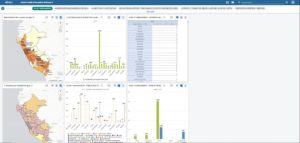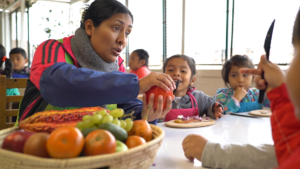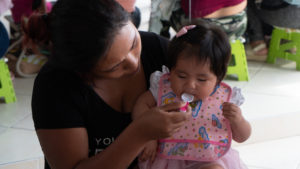Conducting a nutrition stakeholder and action mapping in Peru with the support of the UN Network
* Originally published by the UN Network Peru is the first country in Latin America to conduct a Nutrition Stakeholder and Action Mapping exercise, one of the UNN analytics designed to guide countries in strengthening nutrition multi-sectorality and scale-up. The tool gives stakeholders a comprehensive picture of…
* Originally published by the UN Network
Peru is the first country in Latin America to conduct a Nutrition Stakeholder and Action Mapping exercise, one of the UNN analytics designed to guide countries in strengthening nutrition multi-sectorality and scale-up. The tool gives stakeholders a comprehensive picture of who is doing what, where and how, illustrating geographic and population coverage. The mapping exercise aims to galvanize a range of actors (including government, United Nations agencies, civil society, academia and the private sector), generating qualitative and quantitative data on ‘core nutrition actions’ that are implemented through sectors such as health, food, education and social protection systems.
“For me, the exercise [stakeholder mapping] has been like a puzzle: every time we thought we had all the pieces, we kept finding another one, then another one…,“ says Emilia Villanueva, consultant with the World Food Programme (WFP) in Peru. “I thought it would be a puzzle with only one face, but then we discovered it was more like a Rubik cube with lots of faces.”
Impetus for mapping
Peru has been part of the Scaling Up Nutrition (SUN) Movement since 2010. The country has a population of approximately 32 million and is divided into 25 regions, which are further divided into provinces and districts. Peru is currently classified as an upper-middle income country, and has made some impressive gains in combatting malnutrition with a decline in prevalence of stunting among children under five (CU5) from 31.3 percent in 2001 to 12.9 percent in 2017 (wasting prevalence is 0.5%).[1] National rates for stunting, however, mask some geographic disparities, with three regions showing stunting prevalence of 31 percent.[2] Moreover, overweight and obesity stands at 32 percent for children aged 5‒9 years old.
The country’s adult population also faces a malnutrition burden: 24.2 percent of women and 15.2 percent of men are obese.[1] A recent study showed that a national average of 37.2 percent of people under 15 years old with obesity, high blood pressure or diabetes. This was higher in urban populations (39.6 percent, rising to 43 percent in Lima) than in rural populations (27.5 percent).
There is also a serious challenge with anaemia in Peru, including among infants aged 6‒35 months with national level prevalence at over 40 percent and with the highest region, Puno, at nearly 70 percent. Women of reproductive age have anaemia rates of 18.5 percent.
Catalyst for action
United Nations agencies in Peru utilize the nutrition working group to harmonize their efforts and exchange related information and experiences. The agencies represented in the group include the Food and Agriculture Organization of the United Nations (FAO), the International Fund for Agricultural Development (IFAD), the United Nations Population Fund (UNFPA), the United Nations Children’s Fund (UNICEF), Pan American Health Organization- World Health Organization (PAHO/WHO) and the World Food Programme (WFP), with the latter taking the lead. Different actors in the group, such as non-governmental organizations (NGOs), academia as well as United Nations agencies, had been looking at different ways to give the government ‘a push’ on tackling malnutrition. At the same time, the Government of Peru had decided to focus on reducing rates of anaemia.
 All these efforts coincided with the arrival of a new director at WFP Peru, Tania Goossens, who had previous experience working with UNN analytics in countries such as Mozambique. “When I arrived in mid-2018, anaemia was on everyone’s agenda, starting with the highest levels of government but despite the numerous efforts and investments, the numbers were just not coming down.”
All these efforts coincided with the arrival of a new director at WFP Peru, Tania Goossens, who had previous experience working with UNN analytics in countries such as Mozambique. “When I arrived in mid-2018, anaemia was on everyone’s agenda, starting with the highest levels of government but despite the numerous efforts and investments, the numbers were just not coming down.”
“This made me think that a good place to start would be to do a comprehensive mapping to better understand who is doing what and where, identify gaps and do that analysis to better guide those efforts and investments. Not just of anaemia, but of all key nutrition interventions, given that some regions continue to have high levels of stunting, while obesity and overweight among children has increased significantly. It just seemed like such an opportune [exercise], especially in a country such as Peru where there is genuine interest in tackling malnutrition, high levels of capacity and funding,” says Tania.
The objectives of the mapping exercise were twofold: (1) to inform, sensitize, define and agree on the opportunities to improve the nutritional situation in the country; and (2) to promote coordination between the government, United Nations agencies, private sector, civil society and academia to improve the coverage of nutrition actions in the country. A technical working group was specifically formed for the mapping exercise, comprising: the Ministry of Health, the Ministry of Development and Social Inclusion, a private sector group (Peru 2021), CARE (representative of the NGO group Peru Prevention of Chronic Malnutrition), FAO, IFAD, UNICEF and WFP.
Getting government on board
The government structure in Peru is decentralized so that each region can make their own decisions, although the policy direction is given at national level. According to Emilia, this works in theory, but not necessarily in practice. “Lima has more than 30 percent of the population, which means that most of the action happens here. The challenge is how to improve this kind of practices in the other regions with poor and extremely poor people, for example in the Amazonia region.”
In the past, Peru had good support from donors in terms of technical assistance and budgets through the NGOs in most cases, but in the last decade, the country has experienced economic growth and traditional donors are focusing their efforts elsewhere. The UNN mapping tool was used as a rallying point for wider participation of the nutrition community, and to ensure that all voices were heard.
The information-gathering stage, which began in October 2019, involved over thirty face-to-face meetings and numerous emails and calls until there was consensus on a final twenty nutrition actions to be included in the mapping. The life cycle approach towards nutrition in Peru ensured that stakeholders from five ministries (Ministry of Agriculture and Irrigation; Ministry of Economy and Finance; Ministry of Housing, Construction and Sanitation; Ministry of Health; and Ministry of Production) took part. A total of approximately 100 stakeholders, from national government, civil society, private sector and international NGOs were involved in the mapping exercise.
Adapting tools to address the double burden
As in all countries, nutrition practices have changed in Peru, particularly in the main cities. The increasing consumption of ultra-processed food and decrease in physical exercise has led to a sharp rise in overweight/obesity, particularly among children and teenagers. The mapping findings concluded that this indicator could be substantially improved through a greater number of prevention and early detection actions with adequate coverage. Recent data has also linked higher mortality from COVID-19 to regions with higher prevalence of overweight/obesity and diet-related non-communicable diseases (NCDs).[3] “We wanted to use the stakeholder mapping tool to open people’s eyes about the causes of overweight/obesity,” claims Emilia.
“We couldn’t find strong indicators to address this, although there are at least three actions [from the final twenty] that focus on obesity/overweight, including: promotion of physical activity in the community; training teachers in promoting healthy lifestyle practices; and evaluating [healthy eating in] school canteens.” However, coverage is low and there needs to be more action and budget for such interventions as there is not enough data currently to evaluate outcomes such as behaviour change, or for building teacher capacity.
According to Tania, the mapping was an opportunity to advocate for the development of policies and implementation of actions to address the double burden, given the alarming increase in overweight/obesity in the population, particularly among children and adolescents. “Having worked with the UNN mapping tool in other countries, I also thought Peru could be one of the first countries to expand this to address the double burden, and could thus be of help to other countries similarly affected.”
• Read the full article on the UN Network website – A ‘window of opportunity’ to strengthen nutrition priority actions: Conducting a Nutrition Stakeholder and Action Mapping in Peru

